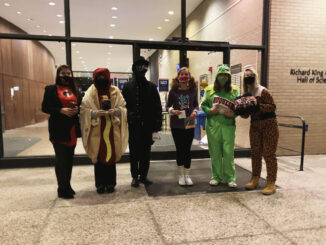
Mia Lubrani | staff columnist
Oct. 28, 2021
We all love Halloween and the endless laughs, candies, costumes and parties that come with it. Dressing up in the brand new costume from Spirit Halloween to go out and seeing what your friends chose to be is a right of passage into adulthood.
I personally spend hours picking my new costume each year, while my mother spends her time picking out decorations and candies for the trick-or-treating.
All these yearly festivities are beloved Halloween traditions, passed down over cultures and generations. Although everything mentioned are integral parts of our holiday, they are not without their flaws.
The Halloween waste crisis has numerous moving parts. Candy, individually wrapped in plastic and aluminum wrappers, takes anywhere from 200 to 1,000 years to decompose in landfills, according to Tree Hugger.
The pumpkin problem also hurts the planet in devastating ways. 1.3 billion pounds of pumpkin go to waste every year, ending up in landfills. Tree Hugger reports that U.S. outsourcing $438.5 billion dollars worth of pumpkins also fuels the greenhouse gas emission.
Two thousand tons of plastic waste — just in costumes — are thrown out in just the United Kingdom every year, reveals the Guardian.
In an age of Amazon and online ordering, the amount of plastic waste being thrown out this year will likely be thousands of tons globally.
The plastic waste stems from costumes, hats, wigs, masks, buckets, party decor, makeup and even pet costumes.
In costumes alone, 83% of the material used is oil-based plastic. Climate Solutions teaches about the dangers of oil-based plastic not being able to break down. The most common plastic polymer found in these costumes was polyester, making up about 69% of all materials wasted. The interaction with the plastics and the chemicals that come with them harm humans’ health and the environment.
The Guardian also shined light on the fact that less than 1% of material used to produce clothing is recycled to create more clothing. Also, four in 10 costumes are worn only one time. Last year, $3.2 billion was spent on these barely used costumes, according to Budget Dumpster. As more people take part in Halloween, the plastic footprint of this holiday will continue to increase.
This year, according to Budget Dumpster, Americans are expected to spend over $2 billion on plastic Halloween decorations. Fake spider webs, mostly made of polyester, take a millennium to break down whilst posing as a huge threat for animals who might consume them.
There are ways that we can all come together to stop the plastic waste issue this upcoming Sunday. I believe if we try to actively stop ourselves, we can at least slow the waste of costumes, decor and candy wrappers.
To start off, we can fix the candy dilemma by making our own treats or sticking with an eco-friendly alternative of Hershey Kisses, bulk unwrapped candy, homemade granola, popcorn or soda cans.
Terracycle is another progressive business specializing in the recycling of wrappers to cut down on the problem.
Terracycle says they are a “social enterprise eliminating the idea of waste.” They tackle a broad range of recycling issues allowing customers to order a box and fill it to be sent back. They work in over 20 countries and with companies to help get rid of hard-to-recycle items.
To solve the “great pumpkin” debate, consider alternative solutions for your pumpkin other than the trash. Pumpkins can be eaten — consider using the flesh in soups, pies or sauces. Try composting or even leaving them in the wilderness for deer, squirrels and chipmunks.
This just in: we can reuse costumes! If your mom, dad, friend, grandma, cousin or even neighbor has costumes and accessories at your disposal, use them. To tackle the one-time-use of costumes, start making costumes with the clothes you wear everyday. Repurpose old clothes and shop at thrift stores if possible. The Salvation Army, Buffalo Exchange and Goodwill are all conveniently located in the South Side waiting for Duquesne students to find their next creative and affordable costume.
If you do do away with a costume, recycle it or donate it. Donations can be made at any thrift store or second-hand store. There are many groups that accept costumes: WEEN DREAM, The Halloween Helpers, Theatre Development Fund and American Textile Recycling Service. Most of these services are mail-in or you can contact each non-profit individually through their websites.
Also, use eco-friendly trick-or-treating bags to stop the plastic revolving door. Use this opportunity to design or encourage designing a custom bag out of eco-material. To make these, use brown paper bags, pillowcases, tote bags, backpacks, drawstrings or old handbags.
If you decorate your home or dorm, make sure to use and continue reusing your decorations.
By implementing these solutions in any way, we can help the crisis of waste and continue having a spooky holiday with respect to the planet.


